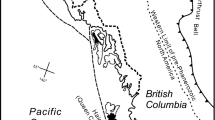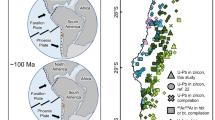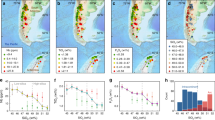Abstract
Large igneous province volcanism represents extensive mantle melting that has contributed to Earth’s chemical differentiation and lithospheric and climatic changes. Compositional heterogeneities in the mantle, such as accumulated recycled crust, may make key contributions to large igneous province activity. One class of rocks capable of producing distinctive mantle heterogeneities is the iron formations, uniquely dense Fe-rich sedimentary rocks formed in Earth’s early oceans. Although numerous iron formations were preserved on continents, with some becoming major Fe ore deposits, large amounts of iron formations may also have been recycled into the mantle, with uncertain consequences. Here we use statistical analysis of time series to show that from 3,200 to 1,000 Myr ago, most iron formation deposition ages are correlated with large igneous province activity 241 ± 15 Myr later, and that these events are coupled on long timescales. Linking observations from tectonics, geodynamics, mineral physics and seismology studies, we hypothesize that dense accumulations of subducted iron formations can form highly conductive Fe-rich zones in the lowermost mantle and facilitate the formation of thermal anomalies that produce mantle plume upwellings, and, ultimately, large igneous provinces. Although uncertainties remain regarding the precise nature of Archaean and Proterozoic convergent tectonics, facilitation of large igneous province activity by subducted iron formations would link Earth’s ocean chemistry to the pace of heat flow, crustal production and chemical differentiation.
This is a preview of subscription content, access via your institution
Access options
Access Nature and 54 other Nature Portfolio journals
Get Nature+, our best-value online-access subscription
$29.99 / 30 days
cancel any time
Subscribe to this journal
Receive 12 print issues and online access
$259.00 per year
only $21.58 per issue
Buy this article
- Purchase on Springer Link
- Instant access to full article PDF
Prices may be subject to local taxes which are calculated during checkout




Similar content being viewed by others
Data availability
All data necessary to reproduce the results of this work are given in the Extended Data and Source Data. Copies of this information, along with the computer code used to generate results and figures, are available from the Zenodo online data repository at https://doi.org/10.5281/zenodo.7843152. Source data are provided with this paper.
Code availability
The computer code used to generate results and figures is available from the Zenodo online data repository at https://doi.org/10.5281/zenodo.7843152.
References
Abbott, D. H. & Isley, A. E. The intensity, occurrence, and duration of superplume events and eras over geological time. J. Geodyn. 34, 265–307 (2002).
Lay, T., Hernlund, J. & Buffett, B. A. Core–mantle boundary heat flow. Nat. Geosci. 1, 25–32 (2008).
Lyons, T. W., Reinhard, C. T. & Planavsky, N. J. The rise of oxygen in Earth’s ocean and atmosphere. Nature 506, 307–315 (2014).
Konhauser, K. O. et al. Iron formations: a global record of Neoarchaean to Palaeproterozoic environmental history. Earth-Sci. Rev. 172, 140–177 (2017).
Bekker, A. et al. in Treatise on Geochemistry 2nd edn, Vol. 9 (eds Holland, H. D. & Turekian, K. K.) 561–628 (Elsevier, 2014).
Planavsky, N. J. et al. Evidence for oxygenic photosynthesis half a billion years before the Great Oxidation Event. Nat. Geosci. 7, 283–286 (2014).
Gole, M. J. & Klein, C. Banded iron-formations through much of Precambrian time. J. Geol. 89, 169–183 (1981).
Johnson, J. E. & Molnar, P. H. Widespread and persistent deposition of iron formations for two billion years. Geophys. Res. Lett. 46, 3327–3339 (2019).
Shirey, S. B. & Richardson, S. H. Start of the Wilson cycle at 3 Ga shown by diamonds from subcontinental mantle. Science 333, 434–436 (2011).
Greber, N. D. et al. Titanium isotopic evidence for felsic crust and plate tectonics 3.5 billion years ago. Science 357, 1271–1274 (2017).
Brenner, A. R. et al. Paleomagnetic evidence for modern-like plate motion velocities at 3.2 Ga. Sci. Adv. 6, eaaz8670 (2020).
Dobson, D. P. & Brodholt, J. P. Subducted banded iron formations as a source of ultralow-velocity zones at the core–mantle boundary. Nature 434, 371–374 (2005).
Kang, N. & Schmidt, M. W. The melting of subducted banded iron formations. Earth Planet. Sci. Lett. 476, 165–178 (2016).
Ernst, R. E. et al. in Large Igneous Provinces: A Driver of Global Environmental and Biotic Changes American Geophysical Union Geophysical Monograph Vol. 255 (eds Ernst, R. E., Dickson, A. J. & Bekker, A.) 1–26 (AGU, 2021).
Condie, K. C., Pisarevsky, S. A., Puetz, S. J., Roberts, N. M. W. & Spencer, C. J. A-type granites in space and time: relationship to the supercontinent cycle and mantle events. Earth Planet. Sci. Lett. 610, 118125 (2023).
Yu, S. & Garnero, E. J. Ultralow velocity zone locations: a global assessment. Geochem. Geophys. Geosyst. 19, 396–414 (2018).
Bower, D. J., Wicks, J. K., Gurnis, M. & Jackson, J. M. A geodynamic and mineral physic model of a solid-state ultra-low velocity zone. Earth Planet. Sci. Lett. 303, 193–202 (2011).
Liu, J. et al. Hydrogen-bearing iron peroxide and the origin of ultralow-velocity zones. Nature 551, 494–497 (2017).
French, S. W. & Romanowicz, B. Broad plumes rooted at the base of the Earth’s mantle beneath major hotspots. Nature 525, 95–99 (2015).
Cottaar, S. & Romanowicz, B. An unusually large ULVZ at the base of the mantle near Hawaii. Earth Planet. Sci. Lett. 355–356, 213–222 (2012).
Yuan, K. & Romanowicz, B. Seismic evidence for partial melting at the root of major hot spot plumes. Science 357, 393–397 (2017).
Lai, V. H. et al. Strong ULVZ and slab interaction at the northeastern edge of the Pacific LLSVP favors plume generation. Geochem. Geophys. Geosyst. 23, e2021GC010020 (2022).
Knittle, E., Jeanloz, R., Mitchell, A. C. & Nellis, W. J. Metallization of Fe0.94O at elevated pressures and temperatures observed by shock-wave electrical resistivity measurements. Solid State Commun. 59, 513–515 (1986).
Fischer, R. A. et al. Phase transition and metallization of FeO at high pressures and temperatures. Geophys. Res. Lett. 38, L24301 (2011).
Ohta, K. et al. Highly conductive iron-rich (Mg,Fe)O magnesiowüstite and its stability in the Earth’s lower mantle. J. Geophys. Res. Solid Earth 119, 4656–4665 (2014).
Manga, M. & Jeanloz, R. Implications of a metal-bearing chemical boundary layer in the D″ for mantle dynamics. Geophys. Res. Lett. 23, 3091–3094 (1996).
Boulard, E. et al. Ferrous iron under oxygen-rich conditions in the deep mantle. Geophys. Res. Lett. 46, 1348–1356 (2019).
Hou, M. et al. Superionic iron oxide-hydroxide in Earth’s deep mantle. Nat. Geosci. 14, 174–178 (2021).
Shim, S.-H. et al. Electronic and magnetic structures of the postperovskite-type Fe2O3 and implications for planetary magnetic records and deep interiors. Proc. Natl Acad. Sci. USA 106, 5508–5512 (2009).
Bykova, E. et al. Structural complexity of Fe2O3 at high pressures and temperatures. Nat. Commun. 7, 10661 (2016).
Khandarkhaeva, S. et al. Structural diversity of magnetite and products of its decomposition at extreme conditions. Inorg. Chem. 61, 1091–1101 (2022).
Nagihara, S., Sclater, J. G., Beckley, L. M., Behrens, E. W. & Lawver, L. A. High heat flow anomalies over salt structures on the Texas continental slope, Gulf of Mexico. Geophys. Res. Lett. 19, 1687–1690 (1992).
Hutko, A. R., Lay, T., Garnero, E. J. & Revenaugh, J. Seismic detection of folded, subducted lithosphere at the core–mantle boundary. Nature 441, 333–336 (2006).
Reali, R. et al. Modeling viscosity of (Mg,Fe)O at lowermost mantle conditions. Phys. Earth Planet. Inter. 287, 65–75 (2019).
Sobolev, A. V., Hofmann, A. W., Jochum, K. P., Kuzmin, D. V. & Stoll, B. A young source for the Hawaiian plume. Nature 476, 434–437 (2011).
Wang, X.-C. et al. Identification of an ancient mantle reservoir and young recycled materials in the source region of a young mantle plume: implications for potential linkages between plume and plate tectonics. Earth Planet. Sci. Lett. 337–338, 248–259 (2013).
Rasmussen, B., Zi, J.-W. & Muhling, J. U-Pb dating reveals multiple Paleoproterozoic orogenic events (Hamersley orogenic cycle) along the southern Pilbara margin (Australia) spanning the onset of atmospheric oxygenation. Geology 50, 959–963 (2022).
Larson, R. L. Latest pulse of Earth: evidence for a mid-Cretaceous superplume. Geology 19, 547–550 (1991).
Driscoll, P. E. & Evans, D. A. D. Frequency of Proterozoic geomagnetic superchrons. Earth Planet. Sci. Lett. 437, 9–14 (2016).
Isley, A. E. & Abbott, D. H. Plume-related mafic volcanism and the deposition of banded iron formation. J. Geophys. Res. 104, 15461–15477 (1999).
Rasmussen, B., Muhling, J. R. & Krapež, B. Greenalite and its role in the genesis of early Precambrian iron formations – a review. Earth-Sci. Rev. 217, 103613 (2021).
Muir, J. M. R. & Brodholt, J. P. Elastic properties of ferropericlase at lower mantle conditions and its relevance to ULVZs. Earth Planet. Sci. Lett. 417, 40–48 (2015).
Badro, J. et al. Iron partitioning in Earth’s mantle: toward a deep lower mantle discontinuity. Science 300, 789–791 (2003).
von Heune, R. & Scholl, D. W. Observations at convergent margins concerning sediment subduction, subduction erosion, and the growth of continental crust. Rev. Geophys. 29, 279–316 (1991).
Plank, T. in Treatise on Geochemistry 2nd edn, Vol. 4 (eds Holland, H. D. & Turekian, K. K.) 607–629 (Elsevier, 2014).
Proust, J. N., Martillo, C., Michaud, F., Collot, J. Y. & Dauteuil, O. Subduction of seafloor asperities revealed by a detailed stratigraphic analysis of the active margin shelf sediments of central Ecuador. Mar. Geol. 380, 345–362 (2016).
Condie, K. C. A planet in transition: the onset of plate tectonics on Earth between 3 and 2 Ga? Geosci. Front. 9, 51–60 (2018).
Palin, R. M. et al. Secular change and the onset of plate tectonics on Earth. Earth-Sci. Rev. 207, 103172 (2020).
Kump, L. R. The rise of atmospheric oxygen. Nature 451, 277–278 (2008).
Seton, M. et al. A global data set of present-day oceanic crustal age and seafloor spreading parameters. Geochem. Geophys. Geosyst. 21, e2020GC009214 (2020).
Labrosse, S. & Jaupart, C. Thermal evolution of the Earth: secular changes and fluctuations of plate characteristics. Earth Planet. Sci. Lett. 260, 465–481 (2007).
Christensen, U. R. & Hoffman, A. W. Segregation of subducted oceanic crust in the convecting mantle. J. Geophys. Res. 99, 19867–19884 (1994).
Li, M. & McNamara, A. K. The difficulty for subducted oceanic crust to accumulate at the Earth’s core–mantle boundary. J. Geophys. Res. Solid Earth 118, 1807–1816 (2013).
Li, M., McNamara, A. K., Garnero, E. J. & Yu, S. Compositionally-distinct ultra-low velocity zones on Earth’s core–mantle boundary. Nat. Comm. 8, 177 (2017).
Cao, X., Flament, N., Bodur, Ö. & Müller, D. The evolution of basal mantle structure in response to supercontinent aggregation and dispersal. Sci. Rep. 11, 22967 (2021).
Dannberg, J. & Sobolev, S. V. Low-buoyancy thermochemical plumes resolve controversy of classical mantle plume concept. Nat. Commun. 6, 6960 (2015).
Van Kranendonk, M. J., Kirkland, C. L. & Cliff, J. Oxygen isotopes in Pilbara Craton zircons support a global increase in crustal recycling at 3.2 Ga. Lithos 228–229, 90–98 (2015).
Condie, K. C., Davaille, A., Aster, R. C. & Arndt, N. Upstairs–downstairs: supercontinents and large igneous provinces, are they related? Int. Geol. Rev. 57, 1341–1348 (2014).
Hiatt, E. E., Kyser, T. K., Polito, P. A., Marlatt, J. & Pufahl, P. The Paleoproterozoic Kombolgie Subgroup (1.8 Ga), McArthur Basin, Australia: sequence stratigraphy, basin evolution, and unconformity-related uranium deposits following the Great Oxidation Event. Can. Mineral. 59, 1049–1083 (2021).
Chamberlain, K. R., Frost, C. D. & Frost, B. R. Early Archean to Mesoproterozoic evolution of the Wyoming province: Archean origins to modern lithospheric architecture. Can. J. Earth Sci. 40, 1357–1374 (2003).
Davey, S. C. et al. Archean block rotation in western Karelia: resolving dyke swarm patterns in metacraton Karelia–Kola for a refined paleogeographic reconstruction of supercraton Superia. Lithos 368–369, 105553 (2020).
Killian, T. M., Bleeker, W., Chamberlain, K., Evans, D. A. D. & Cousens, B. in Supercontinent Cycles Through Earth History Geological Society of London Special Publication Vol. 424 (eds Li, Z. X., Evans, D. A. D. & Murphy, J. B.) 15–45 (GSL, 2016).
Wang, C., Konhauser, K. O. & Zhang, L. Depositional environment of the Paleoproterozoic Yuanjiacun banded iron formation in Shanxi province, China. Econ. Geol. 110, 1515–1539 (2015).
Lan, C., Long, X., Zhai, M. & Wang, J. Depositional age and geochemistry of the 2.44–2.32 Ga granular iron formation in the Songshan Group, North China Craton: tracing the effects of atmospheric oxygenation on continental weathering and seawater environment. Precambrian Res. 357, 106142 (2021).
Gumsley, A. P. et al. Timing and tempo of the Great Oxidation Event. Proc. Natl Acad. Sci. USA 114, 1811–1816 (2017).
Warchola, T. et al. Petrology and geochemistry of the Boolgeeda iron formation, Hamersley Basin, Western Australia. Precambrian Res. 316, 155–173 (2018).
Djoukouo Soh, A. P. et al. Origin, tectonic environment and age of the Bibole banded iron formations, northwestern Congo Craton, Cameroon: geochemical and geochronological constraints. Geol. Mag. 158, 2245–2263 (2021).
Freimann, M. A., Knauer, L. G. & Kuchenbecker, M. New geochronologic and geochemical constraints for the Pedro Pereira metavolcanosedimentary sequence: evidence for a 2.77 Ga oxygen oasis record in the São Francisco–Congo paleocontinent. J. South Am. Earth Sci. 112, 103613 (2021).
Diez, D. M., Barr, C. D. & Çetinkaya-Rundel, M. OpenIntro Statistics 3rd edn (OpenIntro, 2015).
Acknowledgements
We thank M. Krause, K.K.M. Lee, J.K. Gaison, A. Keller and D.A. Keller for discussions. D.S.K., C.-T.A.L. and R.D. received support from NASA grant 80NSSC18K0828. L.J.R. acknowledges support from a Natural Sciences and Engineering Research Council of Canada (NSERC) Discovery Grant (RGPIN-2021-02523).
Author information
Authors and Affiliations
Contributions
D.S.K., S.T. and L.J.R. developed the project. D.S.K. and S.T. conducted time series analysis and D.S.K. conducted tests for statistical significance and Fourier transform analysis. All authors discussed calculations and numerical modelling, which were performed by D.S.K. All authors discussed interpretations of results and their implications. D.S.K. wrote the initial manuscript draft, which all authors discussed and edited together.
Corresponding author
Ethics declarations
Competing interests
The authors declare no competing interests.
Peer review
Peer review information
Nature Geoscience thanks David Dobson and the other, anonymous, reviewer(s) for their contribution to the peer review of this work. Primary Handling Editors: Tamara Goldin and Rebecca Neely, in collaboration with the Nature Geoscience team.
Additional information
Publisher’s note Springer Nature remains neutral with regard to jurisdictional claims in published maps and institutional affiliations.
Extended data
Extended Data Fig. 1 Simplified model of conductive heat flow through IF in the lowermost mantle.
(a): Model setup of IF and D″ mantle at the CMB. IF is taken as 50% Fe-oxides and 50% SiO2 by volume. (b): Model results showing the fraction of heat flow through the IF box for a range of IF thermal conductivities. The thermal conductivity of both D″ mantle and SiO2 in IF are taken to be 10 W m−1K−1 (ref. 2).
Extended Data Fig. 2 Simplified calculations showing that the sum of subducted IF mass would likely fit within a layer ≤4 km thick above the CMB.
If IFs persist in the lowermost mantle, they might remain seismically undetectable with the current resolution limitations of ~5 km above the CMB (ref. 16) in the absence of vertical deformation.
Supplementary information
Supplementary Table 1
Table showing correlations of each IF with each ELIP and the total number of events falling within several age correlation groupings.
Source data
Source Data Fig. 1
All ELIP and IF data plotted in Fig. 1 and the statistical analyses of these data and the synthetic data to which they are compared.
Source Data Fig. 2
ELIP and IF time series used in discrete Fourier transform analysis.
Source Data Extended Data Fig. 1
Calculations and data used to make Extended Data Fig. 1.
Rights and permissions
Springer Nature or its licensor (e.g. a society or other partner) holds exclusive rights to this article under a publishing agreement with the author(s) or other rightsholder(s); author self-archiving of the accepted manuscript version of this article is solely governed by the terms of such publishing agreement and applicable law.
About this article
Cite this article
Keller, D.S., Tassara, S., Robbins, L.J. et al. Links between large igneous province volcanism and subducted iron formations. Nat. Geosci. 16, 527–533 (2023). https://doi.org/10.1038/s41561-023-01188-1
Received:
Accepted:
Published:
Issue Date:
DOI: https://doi.org/10.1038/s41561-023-01188-1



